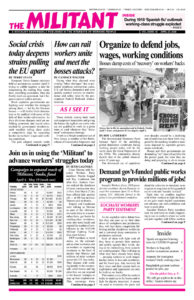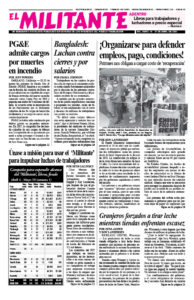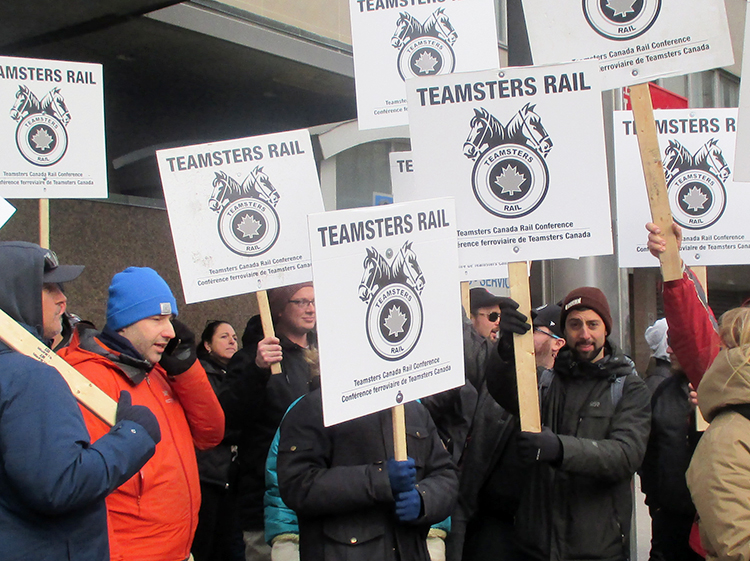Facing what they claimed were coming “labor shortages” due to potential employee coronavirus cases, U.S. rail bosses demanded and were quickly granted waivers on maintenance and safety rules by the pro-employer Federal Railroad Administration.
These include cutting back track and equipment inspections and giving the bosses the right to use crews who are not qualified to work on a given route or yard whenever they “document” a manpower shortage.
I work as a freight conductor out of New Jersey, a member of the Brotherhood of Locomotive Engineers and Trainmen. There’s a lot of discussion among rail workers about this government gift to our bosses.
I tell my co-workers that our unions’ memberships need to organize to demand the return to work today of all furloughed workers; that crews get trained on unfamiliar territory at company expense; and for an increase in inspection and repair of locomotives to protect the safety of both train crews and the public.
For the last several years, North American railroads have been increasing profit margins by laying off mechanical workers and conductors, speeding up operations, running longer and longer trains and squeezing their customers. Over 20 rail workers were killed on the job last year.
“In the last six months, 60% of the rail jobs here in Lincoln have been eliminated, nearly 150 workers have been furloughed,” Lance Anton, a conductor and member of the SMART-TD union in Nebraska, told the Militant.
“They will definitely use this waiver to further their agenda,” Robin Smith, a locomotive engineer and member of the SMART-TD union in Pennsylvania, told me. “Being qualified on the territory is critical for safety. It means knowing where the downgrades are, the signals and road crossings. It also means being able to direct emergency help to your location in the event of a hazardous spill, a fire or a medical emergency.”
Travis Zuluaga, a member of the BLET in the Albany, New York, area, explained that maintenance workers “say they don’t have time to fix anything. At one point one railroad was telling their workers they had seven minutes to fix each engine that came into the shop,” he said. “It’s not uncommon on the railroads for engines in service to have serious safety issues. Sometimes engineers write up engines for needed work, but they are sent right back out without fixing the problems.”
“We know that work can be performed safely,” Anton said. “But only when workers have control over job conditions.”
Last week an engine caught fire in western New Jersey on route to Pennsylvania. Then the following day, at the same location, sparks from a train burned vegetation on both sides of the track for close to five miles. It was just luck that no one was injured or greater damage done.
The Federal Railroad Administration reported more than 1,200 derailments in 2019, with over half of those blamed on equipment or track failures. And that was before the rail bosses get the government’s OK to further cut back on inspections.
Attack on crew size, work conditions
For years rail bosses have been on a drive to cut crew size to boost profits. The Class 1 railroads are on a major campaign today to eliminate the conductor, claiming that the conductors’ duties can be taken over by computer programs. A section of the FRA waiver grants permission for a train operated by a qualified engineer to run at full speed with no restrictions, even though being worked by a conductor not qualified on the territory. This waiver shows the sympathies of the FRA are on the side of the bosses’ drive to eliminate conductors.
I say, let’s use our union power to fight to limit the length of the trains and double the crew size, have an engine or caboose on the rear.
The rail bosses — like all bosses — are using the current social and economic crisis to further their effort to maximize profits at the expense of workers’ jobs and working conditions.
We need to recognize this and work to undercut the divisions promoted by the bosses and learn to use union power to fight for workers control of production and transport.
“Engineers and conductors work together but have been divided by the company,” Zuluaga explains. “We need a single union to represent both.” I add that we need one union for all rail workers industrywide, including crew transport workers. In the meantime, we can all fight together.
Last year conductors and engineers in Framingham, Massachusetts, organized a work-to-rule campaign at the CSX yard there because management was pushing to speed up their work. Last fall Local 1409 of the SMART union organized an informational picket in downtown Kansas City, Missouri, to tell people how Union Pacific rail bosses are laying off workers and threatening rail safety in the area.
We can learn from examples like these, and organize to use our union power to fight back. We need to learn the truth that the union is the membership. Union is when we stand up together and say “no.”
A dead-end strategy is putting union resources into electing “friends of labor” politicians, who supposedly will promote legislation to “help us.” This includes efforts to get state legislatures to pass laws requiring two-person crews on trains in their states. This effort continues months after the Federal Railroad Administration reaffirmed that states have no jurisdiction over the railroads. The working class has never won anything this way. The dwindling numbers in our unions and the growing attacks on our wages and working conditions has been the result of this dead-end perspective.
For our own party, a labor party
I support the call for a labor party that would organize workers, union and nonunion alike, to defend the interests of all the exploited and oppressed. We need to fight for workers control of production. These are the key planks of the campaign of Alyson Kennedy and Malcolm Jarrett, Socialist Workers Party candidates for president and vice president, and all the SWP candidates in 2020.
Today we need to build solidarity with workers wherever they are organizing a fight to defend conditions and wages on the job. “An injury to one is an injury to all.”
Candace Wagner is the Socialist Workers Party candidate for Congress in New Jersey’s 8th District.


